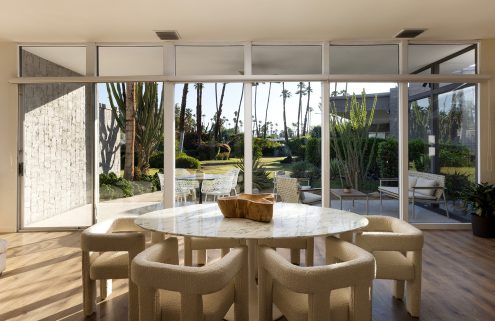This year’s open-air Desert X feels particularly on point for the middle of a pandemic when art galleries across the globe remain shuttered to curb the spread of Covid-19.
With the spotlight on Coachella Valley, organisers of the free biannual event are seizing the moment with 13 politically provocative and immersive installations that reframe the desert surrounds while probing social issues ranging from cultural genocide to environmental decline.
Not everyone can make the journey to the Californian desert, but here are five installations not-to-be-missed – even if it is just experiencing them on a screen.
Womens’ Qualities, Ghada Amer

Egyptian artist Ghada Amer explores ideas around gender and sex in her practice, and for Desert X, she continues her Womens’ Qualities series. Amer has constructed a special garden for contemplation out of words residents of the Coachella Valley have been ascribed, arranged in a circular formation on the Great Lawn at Sunnylands.
Where: Sunnylands Center & Gardens, 37977 Bob Hope Drive, Rancho Mirage
33.780361, -116.409583
Never Forget, Nicholas Galanin

Native Alaskan artist Nicholas Galanin hijacks one of white America’s most instantly recognisable landmarks with his impactful piece, Never Forget, taking the giant Hollywood sign and changing it to read Indianland.
Synonymous with the film studios and starlets of cinema’s Silent era, the original Hollywood sign was originally erected to advertise a racist, whites-only residential development. ‘Land’ was eventually dropped from the sign – just as the territorial rights of the indigenous Cahuilla people were ignored and then conveniently ‘forgotten’. Galanin’s installation of 45-ft-tall letters is impossible to miss.
Where: North of the Palm Springs Visitors Center at Tramway Rd, 2901 N Palm Canyon Dr, Palm Springs
33.5127.7, -116.33’32.8
The Wishing Well, Serge Attukwei Clottey

Artist Serge Attukwei Clottey draws on his Ghanaian roots for The Wishing Well – an installation of giant, sculptural cubes draped with yellow sheets woven from plastic Kufuor jerrycans. Used to transport water in Ghana, Europeans introduced Kufuors to transport cooking oil though they’d been repurposed.
This colonial remnant serves as a reminder of daily inequality, with people in Ghana and other countries forced to trek with these containers to access and store clean drinking water. When placed in the context of the Coachella Valley desert, the installation also poses uncomfortable questions about domestic socio-economic and racial inequalities.
Where: James O. Jessie Desert Highland Unity Center, 480 W. Tramview Road Palm Springs
33.868111, -116.552750
Jackrabbit Homestead, Kim Stringfellow

Kim Stringfellow’s book Jackrabbit Homestead: Tracing the Small Tract Act in the Southern Californian Landscape 1938-2008 also explores migration – albeit migrants capitalising on the law that made the desert accessible to a new demographic of landowners.
For Desert X, Stringfellow has built a 122-sq-ft, 1950s style cabin, which occupies a scrub of land as a signifier for conversations about class, environmental sustainability, public land, gender and race. The hut is outfitted with a stove, table and typewriter, while audio plays the chronicles of Catherine Venn, who recorded her 1950 homesteading experience for Desert Magazine.
Where: Adjacent to the Palm Desert Chamber of Commerce, 72559 Highway 111, Palm Desert
33.723583, -116.400944
The Passenger, Eduardo Sarabia

Desert migrations inform Eduardo Sarabia’s triangular, arrow tip-shaped maze installation, The Passenger, from biblical exoduses to the desperate and dangerous border crossings undertaken by migrants. Sarabia used petates – rugs woven from palm fibres – to create the walls of the structure, which nods to the aspirations and difficulties facing migrants.
Where: Frank Sinatra Drive and Portola Avenue, Palm Desert
33.775917, -116.368694
Desert X runs from 12 March to May 16 2021.























